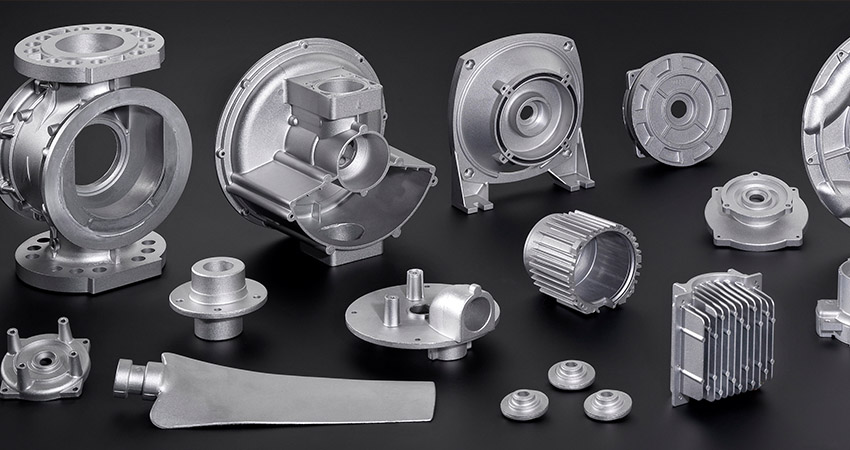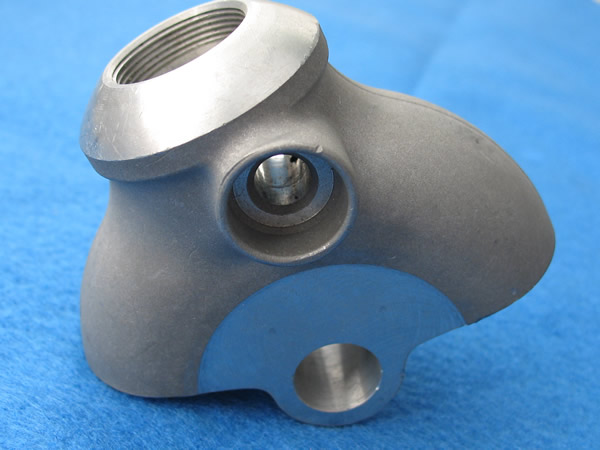Aluminum Casting explained: How it works
Wiki Article
Exploring the Advantages of Utilizing Aluminum Castings in Modern Manufacturing
Aluminum castings have actually ended up being significantly relevant in modern production due to their one-of-a-kind buildings. The lightweight nature of aluminum enables much more intricate layouts, specifically beneficial in sectors like automotive and aerospace. Its corrosion resistance expands item life expectancy, while cost-effectiveness improves production efficiency. These advantages welcome a closer evaluation of aluminum's function in numerous applications and its influence on style versatility and sustainability in producing processes.Lightweight Residences and Their Influence On Design
The lightweight homes of aluminum castings greatly influence modern layout practices across numerous industries. Developers and engineers commonly focus on weight decrease in their tasks to enhance effectiveness and efficiency. This characteristic allows for the creation of complex shapes and layouts that would be testing with heavier materials. In markets such as automotive and aerospace, where every gram counts, aluminum castings add to sustain effectiveness and minimized emissions. In addition, the simplicity of making procedures like die casting enables the manufacturing of complex geometries, leading to cutting-edge item styles. The capacity to stabilize toughness and weight makes aluminum an attractive choice for producers seeking to maximize item functionality while minimizing production costs. As sectors continue to advance, the adoption of aluminum castings is likely to broaden, promoting brand-new chances for design creativity and design improvements. Overall, the light-weight nature of aluminum is an essential consider forming modern production practices.
Superior Rust Resistance for Durability
Lots of products experience from degradation over time, aluminum castings stand out for their remarkable corrosion resistance, significantly improving the longevity of products. This resistance is mostly attributed to the natural development of a protective oxide layer on the aluminum surface, which hinders further oxidation and stops rusting. Unlike steel or iron, aluminum does not corrode easily when subjected to dampness or various chemicals, making it an ideal selection for applications in rough atmospheres.Additionally, aluminum castings preserve structural stability over extended durations, lowering the need for constant replacements. This reliability is crucial in markets such as automobile, aerospace, and marine, where element failure could bring about substantial safety issues. By choosing aluminum castings, producers can guarantee that their products not only sustain the test of time yet also do constantly under tough problems, eventually profiting both manufacturers and end-users with boosted longevity and less upkeep requirements.
Cost-Effectiveness in Production
Cost-effectiveness in aluminum casting manufacturing is driven by numerous essential factors. Minimized material waste adds to reduce manufacturing prices, while fast production times boost total effectiveness. These aspects jointly place aluminum castings as a practical option for suppliers looking for to maximize their operations.Decreased Product Waste
Minimizing product waste in aluminum casting not just boosts sustainability however also noticeably reduces production costs. Effective use of basic materials is crucial in contemporary production, where minimizing waste can cause significant savings. Aluminum casting procedures permit for intricate styles with precise requirements, which helps to optimize product usage and lower extra. Methods such as near-net form casting better restrict the amount of scrap produced during manufacturing. In addition, the recyclability of aluminum adds to a decrease in waste, as remaining products can be melted and reused in future applications. By taking on aluminum casting approaches, makers can achieve not just a much more eco friendly operation yet also a streamlined manufacturing procedure that optimizes resource efficiency and minimizes overall material prices.Lower Production Costs

Quick Manufacturing Times
While many factors add to the total effectiveness of making processes, quick production times stand out as a notable benefit of aluminum casting. This technique permits for the fast creation of elements, greatly reducing lead times. The ability to produce complicated shapes with high accuracy means that makers can rapidly react to market needs and scale production as required. Additionally, aluminum's desirable thermal homes allow quicker cooling prices, better quickening the general casting procedure. Subsequently, much shorter production cycles result in enhanced inventory turnover and minimized functional expenses. By lessening delays and improving throughput, aluminum casting supports a much more nimble production setting, eventually adding to enhanced competitiveness in the industry.Style Versatility and Complex Geometries
Aluminum castings offer impressive style adaptability, allowing the production of complex geometries that would certainly be challenging with other materials. This capacity enables producers to produce lightweight architectural solutions that improve total performance and efficiency. Furthermore, the fast prototyping potential of aluminum castings increases the development procedure, assisting in advancement in design.Intricate Design Capabilities

Lightweight Structural Solutions
Producers increasingly utilize aluminum castings to supply lightweight architectural solutions that do not compromise on stamina or longevity. The fundamental homes of aluminum, including its low thickness and high strength-to-weight proportion, make it an optimal option for applications where weight reduction is vital. This light-weight particular facilitates style adaptability, permitting designers to create complicated geometries that conventional materials may not accommodate. Furthermore, aluminum castings can be customized to details performance requirements, enhancing capability without adding too much weight. This flexibility allows the manufacturing of elaborate elements for numerous industries, such as aerospace and automotive, where effectiveness and efficiency are critical. On the whole, aluminum castings play a crucial role in advancing modern manufacturing via innovative structural layouts.Quick Prototyping Possible
Quick prototyping has actually arised as a game-changer in contemporary manufacturing, specifically when it involves design versatility and the capacity to produce intricate geometries. Aluminum castings facilitate this advancement, allowing engineers to produce elaborate styles that would be difficult or difficult with typical techniques. The light-weight nature of aluminum boosts the convenience of manipulation throughout the prototyping stage, making it possible for fast iterations and alterations. The material's excellent thermal conductivity and deterioration resistance add to the longevity of prototypes, making them appropriate for testing in real-world problems. Consequently, suppliers can accelerate product advancement cycles, reduce expenses, and enhance advancement. Inevitably, the assimilation of aluminum castings right into fast prototyping processes supports the development of sophisticated, high-performance elements customized to specific applications.Enhanced Thermal and Electric Conductivity
While aluminum castings are renowned for their lightweight properties, their boosted thermal and electrical conductivity likewise plays a crucial function in modern production. This characteristic makes aluminum an optimal option for applications needing reliable heat dissipation and electrical performance. Parts in electronic devices benefit from aluminum's capacity to properly transfer warm, thus decreasing the danger of getting too hot and lengthening gadget life expectancy. In vehicle and aerospace sectors, aluminum castings add to boosted thermal administration systems, promoting power effectiveness.The high electric conductivity of aluminum allows for its widespread usage in electric parts, such as adapters and bus bars. This feature not only lowers energy loss throughout transmission however additionally improves overall performance. The combination of these residential or commercial properties placements aluminum castings as a recommended product in many applications, driving advancement and effectiveness in producing processes throughout numerous industries.
Sustainability and Ecological Benefits
Aluminum castings provide substantial sustainability and environmental benefits, aligning with the growing focus on environment-friendly production techniques. One of the key benefits of aluminum is its recyclability; up to 95% of aluminum can be reused without losing top quality. This process takes in just a portion of the power required for primary production, considerably decreasing greenhouse gas discharges.Additionally, aluminum is light-weight, which contributes to power efficiency in transportation and item usage. Its toughness and resistance to corrosion expand the life-span of items, reducing waste and the need for regular substitutes. In addition, the use of aluminum castings can bring about much more reliable manufacturing procedures, as they frequently need much less power and material compared to standard techniques.
Applications Across Numerous Industries
As markets progressively seek functional products for cutting-edge applications, aluminum castings have arised as a prominent choice across various fields. In the automobile market, lightweight aluminum castings add to enhanced gas performance and efficiency, while in aerospace, they offer strength without endangering weight, Aluminum Casting necessary for airplane style. The consumer electronics industry gain from aluminum's excellent thermal conductivity, making it perfect for heat sinks and enclosures. In enhancement, the construction sector utilizes aluminum castings for window frames, roof covering elements, and architectural components due to their durability and resistance to deterioration. The clinical devices sector relies on aluminum castings for creating precise, lightweight parts that meet stringent hygiene standards. These diverse applications highlight the adaptability of aluminum castings, making them a favored product for makers aiming to introduce and enhance item performance throughout different areas.Regularly Asked Questions
Exactly How Are Aluminum Castings Produced in the Production Refine?
Aluminum castings are created via a procedure entailing melting aluminum, putting it right into molds, and permitting it to strengthen. Aluminum Casting. This method enables the development of complicated shapes and precise measurements required in numerous applicationsWhat Precaution Are Needed When Collaborating With Aluminum Castings?
When dealing with aluminum castings, essential precaution include putting on protective equipment, guaranteeing appropriate air flow, applying fire safety protocols, and preserving tools to avoid accidents, thereby guarding workers against potential risks linked with the casting process.Can Aluminum Castings Be Recycled, and How Is This Done?
Aluminum castings can undoubtedly be recycled effectively. The procedure entails gathering scrap aluminum, thawing it down in furnaces, and afterwards reforming it into new products, thus saving sources and reducing ecological influence in production.What Are the Typical Problems in Aluminum Castings and Exactly How to Avoid Them?
Typical issues in aluminum castings consist of porosity, shrinkage, and surface flaws. To stay clear of these problems, proper mold style, temperature control, and product option are vital, making certain suitable casting conditions and lowering the possibility of problems.How Do Aluminum Castings Contrast to Various Other Materials in Terms of Strength?
Aluminum castings show desirable strength-to-weight proportions compared to several products - Aluminum Casting. While normally much less solid than steel, they outshine plastics and use enough strength for various applications, making them a versatile selection in making processesReport this wiki page